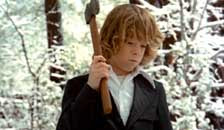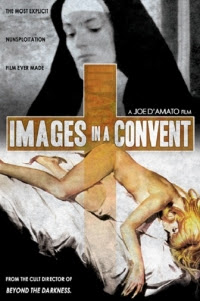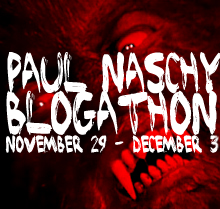
Now THIS is what is so great about all those dollar dvds and budget public domain sets the Duke and I have become addicted to! For every few stinkers and so-bad-they're-funny freakouts you find, you'll come across some forgotten, unknown gem of cinema, some movie that for one reason or another fell by the wayside but can still jump up and knock your socks off. I'm thinking Messiah of Evil. I'm thinking Castle of Blood. And now, I'm thinking the 1973 French/Spanish production La Campana del Infierno, aka The Bell from Hell.
Borrowing equally from Hitchcock, Bava, and Luis Buñuel, but with a wicked little streak all its own, this is a movie that crawls inside your head and stays there. Great acting, wonderful cinematography, and a story that never lets you get comfortable and always keeps you guessing what will happen next--The Bell from Hell is an unknown masterpiece that I'd never have watched if not for the public domain dvd profiteers who, let's face it, could care less what they put out there. Still, they deserve the thanks of cinematic treasure hunters like us, especially when they preserve booty like this.
We open with a beautifully photographed and puzzling scene in which our protagonist/antihero John is sitting calmly in a cell-like room, waiting for the plaster on his face to dry. He's apparently making a bust of himself as part of some personal hobby--we won't find out the results until later. Once that's all done we learn that John is a guest at a mental institution, from which he is about to be released. Once he's out we follow him on a trip via motorcycle to his old home town, where he reacquaints himself with his aunt, his three lovely female cousins, and an old flame who just married a rich older man with political connections in the town.
Along the way he takes a job for a few days at a slaughterhouse (quitting when he tells his foreman, ominously, "I've learned enough!"), and also meets with a strange old wood-dwelling hermit and the old man's mute, nubile young daughter, leading to one of many memorable dialog exchanges in the film:
The hermit: "When you were born, already Satan dealt the cards!"
John (smiling in a blank, evil way): "Maybe--but I'LL play them!"
The director(s) keep us in suspense about what exactly is going on with John and where the story is going, but give us just enough intrigue to keep us following along, desperate for the next piece of the puzzle. Bit by bit we learn that John had been confined for allegedly attempting to rape one of his cousins--and indeed, he does have a strangely close relationship with the youngest of his relatives, the gorgeous Maribel Martín (who also made an impression in The Blood-Spattered Bride). The plot is thicker than that, however, as we soon learn that John's Aunt Marta, his legal guardian and mother of the girls, is in charge of John's mother's estate (and riches) so long as John is not "competent." Was John really insane, or did his aunt have him committed so she and her daughters could live in luxury? At times even John seems not to be sure.
That uncertainty haunts both us and the characters and more facets of John's personality are revealed. He is a practical joker par excellence, as demonstrated by a wonderful scene early on where he scares the pants off his old flame's husband with a very creepy and well-timed ghost story. But the jokes turn disturbing when, after telling his old flame how he'd rather rip out his eyes than do her harm, he appears to do just that! Through this we learn not only that John is a master of makeup and disguise, but also that he is more than a little messed up, and more than a little scary because of it.
As the film progresses and John's jokes become more and more pointed, more and more edgy, we begin to wonder just how far he's willing to go--and to what purpose. It all comes to a head when, after some cryptic but fascinating preparations, John invites his Aunt Marta and her daughters to the house for an evening of revelations and surprises, which soon devolves into an amazing unfolding of John's plans leading up a powerhouse conclusion that calls Hostel to mind, more than 30 years earlier. What happens as a result of this evening--and what happens after, just when you think everything's been tied up--has to be seen to be appreciated. I was shocked, delighted, and creeped out--and more important, still thinking it through as the disc finished playing. And even now.
This is a movie it would be criminal to spoil, so I'll just leave off with the plot summary there. Suffice to say the story is fantastic, and keeps you thinking long after the final strains of music cease. (Just WHO was it that got the last laugh?)
But I can still talk about some of the other things the movie gets right--which is just about everything. The acting is great from top to bottom--Renaud Verley as John is a standout, very cold and calculating, never letting anyone past the flat plastic-like surface of his devilish, impish insanity. The cousins are interesting characters each in their own right, and Aunt Marta is, as one reviewer put it, the very picture of rural aristocratic decay--a theme you'll see played out a lot in the imagery of the film.
And what wonderful imagery! Some truly amazing artistic compositions pepper this film, and the cinematography is so great it shines through the admittedly substandard print on the 50 Chilling Classics set. The repeated imagery of the village church's new bell, which is being hauled to town and installed as the lurid events of John's saga play out, work so well as a metaphorical motif that when it moves from a symbol to an actor in the events, it's quite a shock. Other shots use extreme close-ups of beautiful objects in the foreground to obscure the sordid stuff going on behind it--such as the lovely, vivid red roses pushed right up to the camera as, behind them, John completes the crime for which he was incarcerated. Fascinating, beautiful stuff, and always with a storytelling purpose. When a movie's scenery is as much fun to look at as the focal action, you know the director is an artist.
And about that director: Claudio Guerín famously fell to his death from the bell tower in which the title object was being hung, close to the end of principal shooting on The Bell from Hell. I think it's a real shame--if this movie is any indication, he would have been one of the great ones. But props must be given to Juan Antonio Bardem, who took the footage Guerin shot and edited it together in a tight, disturbing package that grabs you and won't let you go.
The only downside I can think of is one that wasn't the film's fault--the audio on the dvd is very, very bad, so low sometimes it was hard to understand what was being said. Still, it didn't prevent my enjoyment; it just cemented my determination to get a better copy if it's ever fully restored--if it even CAN be, given the state of many of these "lost" films.
But in whatever form, I'm very glad I saw it. Three thumbs, easily. Find yourself a copy. This is one to go out of your way for.































